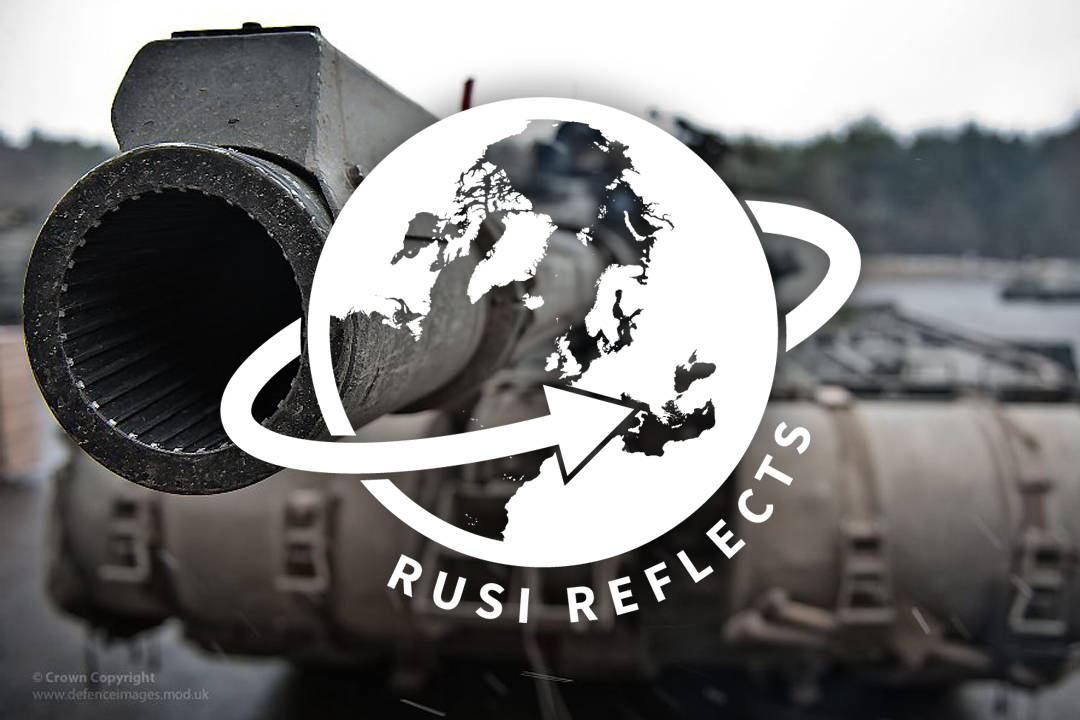Waiting for Godot? The UK’s Defence Command Paper Refresh
While the refresh of the Defence Command Paper demonstrates an effort to get organisationally ready for the future, the constraints of time and money ultimately undermine its value as a national defence response to a more contested and volatile world.
Following the refresh of the UK’s Integrated Review in March 2023, Defence has released its (delayed) response. The 97-page document was trailed by one minister at RUSI’s Land Warfare Conference as intending to be dull, and for those put off by its length or lack of detail on the force structure, it may exceed his expectations. However, this would unfairly characterise the situation facing the drafters once the excitement of the commitment to 3% of GDP allocated to Defence under Liz Truss’s premiership was replaced by her successor’s looser commitment to 2.5% ‘as fiscal and economic circumstances allow’. Without new money beyond that of the Spring Budget, with the old money already under stress from rising costs, and with no time in the political cycle for substantive change, bold statements of new capability would have been meaningless, or worse. Understandably, therefore, the Command Paper Refresh focuses on areas that the Ministry of Defence (MoD) and armed forces can act on quickly and, at this stage of planning at least, relatively cheaply. What this leaves, however, is a Command Paper that is more of a message about how Defence needs to get ready for the next Defence Review, probably taking place in 2025, when it will align with a comprehensive spending review. Important decisions about force structure, therefore, have been put off until then.
Unlike the Refresh of the Integrated Review, whose priorities were memorably described by Paul Cornish as being ‘everything, everywhere, all at once’, the Command Paper Refresh explicitly prioritises a ‘Global Response Force’ configured for warfighting in the Euro-Atlantic area, but able to be used elsewhere, including in the Indo-Pacific and Africa. This accords with the Integrated Review Refresh’s view of the Indo-Pacific as more about diplomatic, information and economic levers of power, while the military should focus on Europe, for now. The Command Paper Refresh also promises a fresh honesty about the UK’s ability to meet its NATO commitments, although that honesty is likely to be reserved for classified documents. Given the lack of mass in both the Army and RAF in particular, the shortfalls in the UK’s NATO contribution within the Euro-Atlantic area can be guessed. But acknowledging the gaps is not enough; they need to be filled, something largely deferred for 2025’s Review. The same is true of a plan for the Reserves to provide the second or even third echelon forces for enhanced resilience, both in support of the regular force and in the UK. And in the latter case, this will require a broad approach involving all of government, industry and civil society, because – as Ukraine shows – domestic resilience is a national endeavour.
The headmark force – the Global Defence Force – delivers the integrated force defined in the Integrated Operating Concept 2025, but appears to be rebranding, albeit within a new governance framework – the Global Operate Programme – rather than being a force with capabilities different to that described in the 2021 Defence Command Paper. There are no big new investment commitments, and nowhere in the document can someone wanting to explore the implications for a single Service find clarity about what that Service is building towards. Readers will have to read the 69 pages of the 2021 Defence Command Paper alongside the (longer) ‘Refresh’ to get a clear picture of the planned force structure.
As with the earlier Command Paper, the Refresh is stronger at describing the issues and introducing new concepts than detailing how implementation will actually occur
In endorsing the original Command Paper’s force structure, the Refresh inherits its flaws: a focus on modernisation and an over-reliance on technology at the expense of conventional mass, on the assumption that once modernised, there will be enough time to regrow the force. That assumption appears questionable given the war in Ukraine, so continuing a strictly sequential path of modernisation and then mass seems similarly flawed. Hence, if from an official’s perspective the refreshed Command Paper is a valiant attempt to make the best of the circumstances, it fails the test of being a credible plan for the armed forces the UK actually needs. If the threat is accelerating, Defence needs new spending, not just on stockpiles and the nuclear capability announced in the Spring Budget, but on conventional mass to avoid increasing the capability gap between the conventional and nuclear rungs on the escalation ladder. If the gap gets too big, it will leave those contemplating integrated deterrence and defence unable to bridge the two, to the detriment of both conventional and nuclear capabilities.
The Paper’s four main themes for securing strategic advantage are matters over which it has some control – people, science and technology, industry and productivity – and make sense in the context of getting fit for the 2025 Review. And, as with the earlier Command Paper, the Refresh is stronger at describing the issues and introducing new concepts (Global Operate Programme, zig-zag careers, new partnerships with industry) than detailing how implementation will actually occur. On People, it accepts the Haythornthwaite Review in full, including the need for greater agility in career paths – although the path to implementation remains opaque. And in one of its few explicit commitments, the Refresh states that Defence will spend £400 million over two years on improving accommodation. The situation for the civil service is less positive, with a recruitment ban imposed separately – partly to help Defence afford the 2023 pay rise for military personnel, the money for which will come from the existing Defence budget and will have to be found from elsewhere.
On science and technology, the Refresh doubles down on earlier commitments underpinned by a continued belief that technology – including semiconductors, AI, quantum and telecommunications – will provide the answers. It reiterates the 2021 Command Paper’s ambition to embrace a culture of innovation and experimentation, with Defence taking more risk on rapid initial entry into service and subsequent spiral development of capabilities through a technology-centric (rather than platform-centric) approach. This requires closer partnership with industry, hence the value of focusing on the relationship with industry to allow this to happen: Ukraine has shown the importance of the industrial base, and the current industrial base is one that Defence has created, so can recreate with the right incentives and behaviours. Acquisition reform – inevitably perhaps – is referenced, as is the need to engage industry in requirement-setting, but a cynic might have hoped for more by way of implementation given that the Defence and Security Industrial Strategy was released two years ago. So, while this is not new, the desire to act on it is restated and has been brought into sharper focus.
The realistic purpose of this refresh is to get Defence fit for the next Command Paper and focus activity in the short term, but it is not a response to the defence challenges the UK faces
Finally, the paper majors on productivity through a ‘campaigning approach’ that will extract greatest value from the Global Response Force. While understandable, and in many respects sensible where the aim is to make the forces more deployable, there are big tensions. Firstly, all organisations find transformation difficult, but this is exacerbated where capacity is consumed in other activity; in some respects, being less productive in the short term could be a quicker path to modernisation. This is not to argue that greater productivity is not needed, but the Paper lacks the detail to know how the balance between productivity and change will play out across the different elements of Defence. Secondly, there is the challenge of resources. Productivity is demanding in terms of running costs through increased consumables, allowances and so on, all of which have already been affected by high rates of inflation. This adds to the pre-existing affordability challenge, where most additional funding has gone into capital costs (CDEL) at the expense of resource ones (RDEL). When the pay settlement and extra costs for improving accommodation are added, RDEL will be under even greater pressure. The other resource challenge is that of the people needed to do the work to make more use of the force. The civilian recruitment ban and potential reductions of up to 3,000 civil servants would represent 5% of the Defence civil service workforce and are to be achieved through natural wastage; it is not targeted. Consequently, gaps could appear in critical areas needed to enable the enhanced productivity the Department is seeking. Finally, the Refresh makes clear that the Levene Model will be reviewed to make sure the governance systems will be in place to manage the Department, but realistically, this will have to inform the next major Defence Review rather than shaping the response to this one.
Overall, the authors have done well to find something meaningful to say – and perhaps more importantly, not to say things that were impossible – so this is an admirable attempt by the Department to satisfy the demand for a refresh to the Command Paper and get organisationally ready for the future. However, if it is worthy as a departmental paper, the constraints of time and money ultimately undermine its value as a national defence response to a more contested and volatile world. The priorities, while basically sound, arguably did not need a command paper at all – internal management of Defence is normally something that the taxpayer might expect Defence to do routinely, but having been announced, the bureaucratic process would have moved inexorably to deliver it, irrespective of the practical necessity for doing so. And even if the MoD can produce a new Defence Strategy and refresh its existing (internal) Defence Plan quickly – that is, before April 2024 – there is not enough time for a meaningful change of direction for the Defence supertanker, which turns slowly. The realistic purpose of this refresh of the Command Paper, therefore, is to get the organisation fit for the next one and focus activity in the short term, but it is not a response to the defence challenges the UK faces. It does, however, fire the starting gun for the next major defence and security review, in which Defence must hope that more time and money will allow it to build the forces the UK needs to deliver against a clear policy headmark of a force optimised for warfighting in the Euro-Atlantic area. We must hope that this expectation does not leave the armed forces waiting for Godot.
The views expressed in this Commentary are the author’s, and do not represent those of RUSI or any other institution.
Have an idea for a Commentary you’d like to write for us? Send a short pitch to commentaries@rusi.org and we’ll get back to you if it fits into our research interests. Full guidelines for contributors can be found here.
WRITTEN BY
Paul O’Neill CBE
RUSI Senior Associate Fellow, Military Sciences
- Jim McLeanMedia Relations Manager+44 (0)7917 373 069JimMc@rusi.org



